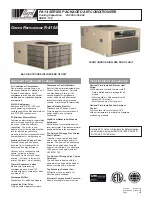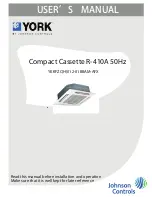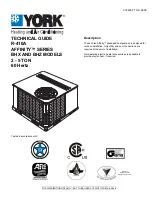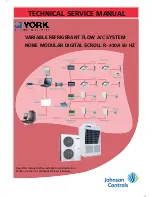
2. Disconnect the wiring to the gas valve, hot surface ignitor
and flame sensor.
3. Loosen the four (4) #10 screws holding the manifold in
place.
4. Pull the manifold gas valve assembly out of the unit.
5. Burners are now accessible for service.
HOT SURFACE IGNITOR INSTRUCTIONS
To check or change the ignitor, CLOSE THE MAIN MANUAL
SHUT-OFF VALVE AND SHUT OFF ALL POWER TO THE
UNIT.
1. Disconnect the wiring to the ignitor.
2. Remove the one screws holding the ignitor in place.
3. Pull the ignitor straight out.
REMOTE SENSOR INSTRUCTIONS
To check or change the remote sensor, CLOSE THE MAIN
MANUAL SHUT-OFF VALVE AND SHUT OFF ALL POWER
TO THE UNIT.
NOTE: The sensor is located on the bottom of the burner
manifold.
1. Disconnect the remote sensor wiring.
2. Remove the screw shoulder combination holding the sen-
sor in place.
3. Pull the sensor straight out.
ADJUSTMENT OF TEMPERATURE RISE
The temperature rise (or temperature difference between the
return air and the heated air from the furnace) must lie within
the range shown on the AGA or CGA rating plate and the data
in Tables 2 and 3.
After the temperature rise has been determined, the CFM can
be calculated as follows:
After about 20 minutes of operation, determine the furnace
temperature rise. Take readings of both the return air and the
heated air in the ducts about six feet from the furnace where
they will not be affected by radiant heat. Increase the blower
CFM to decrease the temperature rise; decrease the blower
CFM to increase the rise.
DIRECT DRIVE BLOWER
All units have direct drive multi-speed blower motors. Refer to
the unit wiring diagram and connect the blower motor for the
desired CFM.
CHECKING GAS INPUT
NATURAL GAS
1. Turn off all other gas appliances connected to the gas meter.
2. With the furnace turned on, measure the time needed for one
revolution of the hand on the smallest dial on the meter. A
typical gas meter usually has a 1/2 or a 1 cubic foot test dial.
3. Using the number of seconds for each revolution and the
size of the test dial increment, find the cubic feet of gas
consumed per hour from Table 9.
If the actual input is not within 5% of the furnace rating with
allowance being made for the permissible range of the regula-
tor setting, replace the orifice spuds with spuds of the proper
size.
NOTE: To find the BTU input, multiply the number of cubic feet
of gas consumed per hour by the BTU content of the gas
in your particular locality. (Contact your gas company for
this information since it varies widely from city to city.)
SECURE OWNER’S APPROVAL
When the system is functioning properly, secure the owner’s
approval. Show him the location of all disconnect switches and
the thermostat. Teach him how to start and stop the unit and how
to adjust temperature settings within the limitations of the system.
Seconds
for One
Rev.
Size of Test Dial
1/2 cu. ft.
1 cu. ft.
10
180
360
12
150
300
14
129
257
16
113
225
18
100
200
20
90
180
22
82
164
24
75
150
26
69
138
28
64
129
30
60
120
32
56
113
34
53
106
36
50
100
38
47
95
40
45
90
42
43
86
44
41
82
46
39
78
48
37
75
50
36
72
52
35
69
54
34
67
56
32
64
58
31
62
60
30
60
Example: By actual measurement, it takes 38 seconds for the hand on the 1-cubic foot dial to
make a revolution with just a 100,000 BTUH furnace running. Using this information, locate 38
seconds in the first column of Table 9. Read across to the column headed “1 Cubic Foot,”
where you will see that 95 cubic feet of gas per hour are consumed by the furnace at that rate.
Multiply 95 x 1050 (the BTU rating of the gas obtained from the local gas company). The result
is 99,750 BTUH, which is close to the100,000 BTUH rating of the furnace.
TABLE 8 - GAS RATE-CUBIC FEET PER HOUR
°
F Temp. Rise =
BTUH Input
(OR) CFM =
BTUH Input
1.35 x CFM
1.35 x
°
F Temp. Rise
530.44-N5Y
10
Unitary Products Group






























